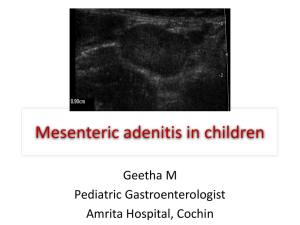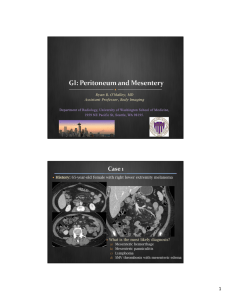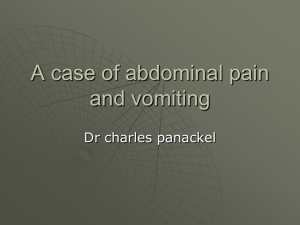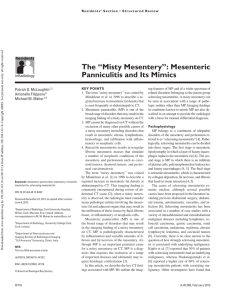Mesenteric panniculitis
advertisement
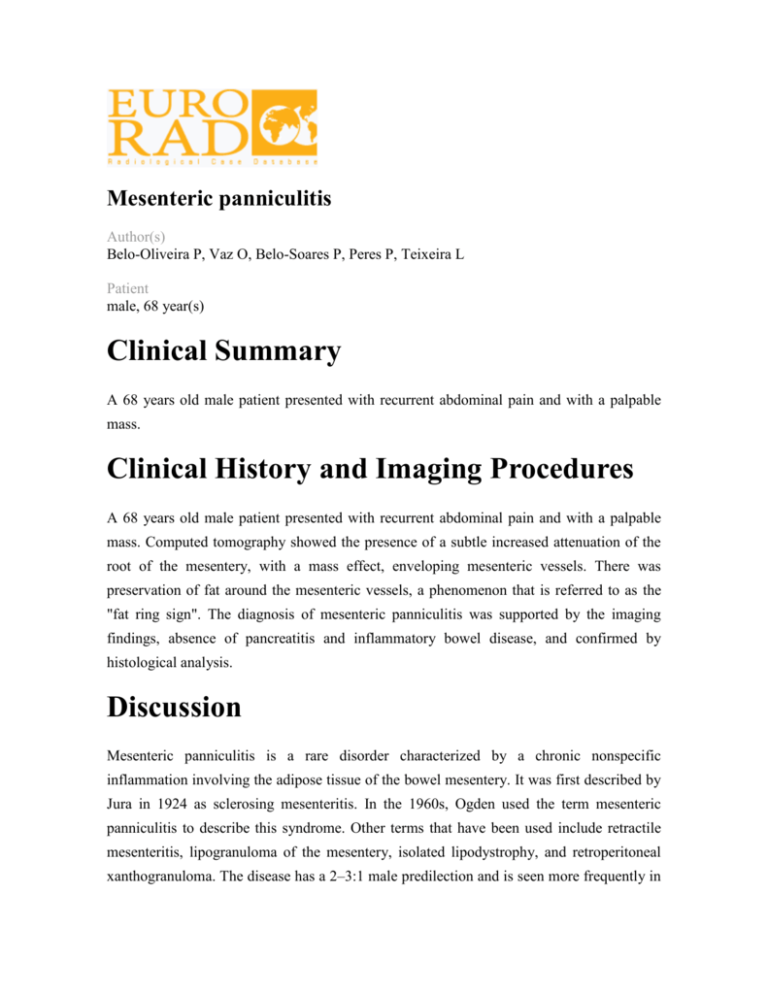
Mesenteric panniculitis
Author(s)
Belo-Oliveira P, Vaz O, Belo-Soares P, Peres P, Teixeira L
Patient
male, 68 year(s)
Clinical Summary
A 68 years old male patient presented with recurrent abdominal pain and with a palpable
mass.
Clinical History and Imaging Procedures
A 68 years old male patient presented with recurrent abdominal pain and with a palpable
mass. Computed tomography showed the presence of a subtle increased attenuation of the
root of the mesentery, with a mass effect, enveloping mesenteric vessels. There was
preservation of fat around the mesenteric vessels, a phenomenon that is referred to as the
"fat ring sign". The diagnosis of mesenteric panniculitis was supported by the imaging
findings, absence of pancreatitis and inflammatory bowel disease, and confirmed by
histological analysis.
Discussion
Mesenteric panniculitis is a rare disorder characterized by a chronic nonspecific
inflammation involving the adipose tissue of the bowel mesentery. It was first described by
Jura in 1924 as sclerosing mesenteritis. In the 1960s, Ogden used the term mesenteric
panniculitis to describe this syndrome. Other terms that have been used include retractile
mesenteritis, lipogranuloma of the mesentery, isolated lipodystrophy, and retroperitoneal
xanthogranuloma. The disease has a 2–3:1 male predilection and is seen more frequently in
patients over 50 years old. Children are rarely affected, possibly because they have less
mesenteric fat. The cause of this rare disease remains unclear. The disease progresses
through three pathologic manifestations: degeneration of mesenteric fat (mesenteric
lipodystrophy), inflammatory reaction (mesenteric panniculitis), and fibrosis of the adipose
tissue (retractile mesenteritis). The diagnosis of mesenteric panniculitis is supported by the
absence of pancreatitis and inflammatory bowel disease. Definitive diagnosis is often made
at histologic analysis following laparotomy or laparoscopy. Multiple biopsies are essential
for diagnosis, especially with nodular or omental involvement. The differential diagnosis
must include the more frequently encountered mesenteric tumours such as lymphoma,
lymphosarcoma, and desmoid tumor. Kipfer et al found that 15% of patients with
mesenteric panniculitis also had associated malignant lymphoma at follow-up. The CT
appearance of sclerosing mesenteritis can vary from subtle increased attenuation in the
mesentery to a solid soft-tissue mass. Sclerosing mesenteritis most commonly appears as a
soft-tissue mass in the small bowel mesentery, although infiltration of the region of the
pancreas or porta hepatis is also possible. The mass may envelop the mesenteric vessels,
and, over time, collateral vessels may develop. There may be preservation of fat around the
mesenteric vessels, a phenomenon that is referred to as the "fat ring sign". This finding may
help distinguish sclerosing mesenteritis from other mesenteric processes such as
lymphoma, carcinoid tumor, or carcinomatosis. Calcification may be present, usually in the
central necrotic portion of the mass, and may be related to the fat necrosis. Cystic
components have also been described and may be the result of lymphatic or venous
obstruction as well as necrotic chang. Enlarged mesenteric or retroperitoneal lymph nodes
may also be present. Treatment of sclerosing mesenteritis is usually empirical and may
consist of therapy with steroids, colchicine, immunosuppressive agents, or orally
administered progesterone. Surgical resection is sometimes attempted, but complete
removal is often difficult due to vessel compromise and may be of no clear benefit to the
patient. In cases of colonic involvement by sclerosing mesenteritis, a colostomy may be
necessary because complete surgical resection is often not technically possible. With
surgical and medical treatment, some patients will follow a relatively benign course,
whereas others will experience progression of the disease, which eventually leads to death.
In some cases, the process resolves completely. CT with three-dimensional volume
rendering is the optimal study for accurate, non-invasive follow-up of the volume, extent,
and vascular involvement of the mass and of any potential complications.
Final Diagnosis
Mesenteric panniculitis
MeSH
1. Panniculitis, Peritoneal [C06.844.600]
Condition of the peritoneum, most commonly of the mesentery, but also of the
omentum, characterized by tissue thickening, alteration of fat cells, infiltration of
lipid-laden macrophages, and fibrosis.
References
1. [1]
Unusual nonneoplastic peritoneal and subperitoneal conditions: CT findings.
Pickhardt PJ, Bhalla S. Radiographics. 2005 May-Jun;25(3):719-30
2. [2]
Mesenteric panniculitis: US and CT features. van Breda Vriesman AC, Schuttevaer
HM, Coerkamp EG, Puylaert JB. Eur Radiol. 2004 Dec;14(12):2242-8. Epub 2004
Aug 5
3. [3]
CT evaluation of mesenteric panniculitis: prevalence and associated diseases.
Daskalogiannaki M, Voloudaki A, Prassopoulos P, Magkanas E, Stefanaki K,
Apostolaki E, Gourtsoyiannis N. AJR Am J Roentgenol. 2000 Feb;174(2):427-31.
Citation
Belo-Oliveira P, Vaz O, Belo-Soares P, Peres P, Teixeira L (2005, Jun 17).
Mesenteric panniculitis, {Online}.
URL: http://www.eurorad.org/case.php?id=3858
DOI: 10.1594/EURORAD/CASE.3858
To top
Published 17.06.2005
DOI 10.1594/EURORAD/CASE.3858
Section Gastro-Intestinal Imaging
Case-Type Clinical Case
Views 70
Language(s)
Figure 1
Abdominal computed tomography
Abdominal computed tomography showing the presence of a subtle increased attenuation
of the root of the mesentery, with a mass effect, enveloping mesenteric vessels.
Figure 2
Abdominal computed tomography
\"fat ring sign\"- preservation of fat around the mesenteric vessels (arrow)
Figure 3
Abdominal computed tomography
Abdominal computed tomography showing the presence of a subtle increased attenuation
of the root of the mesentery, with a mass effect, enveloping mesenteric vessels.
Figure 4
Abdominal computed tomorgaphy
Abdominal computed tomography showing the presence of a subtle increased attenuation
of the root of the mesentery, with a mass effect, enveloping mesenteric vessels.
Figure 1
Abdominal computed tomography
Abdominal computed tomography showing the presence of a subtle increased attenuation
of the root of the mesentery, with a mass effect, enveloping mesenteric vessels.
Figure 2
Abdominal computed tomography
\"fat ring sign\"- preservation of fat around the mesenteric vessels (arrow)
Figure 3
Abdominal computed tomography
Abdominal computed tomography showing the presence of a subtle increased attenuation
of the root of the mesentery, with a mass effect, enveloping mesenteric vessels.
Figure 4
Abdominal computed tomorgaphy
Abdominal computed tomography showing the presence of a subtle increased attenuation
of the root of the mesentery, with a mass effect, enveloping mesenteric vessels.
To top
Home Search History FAQ Contact Disclaimer Imprint
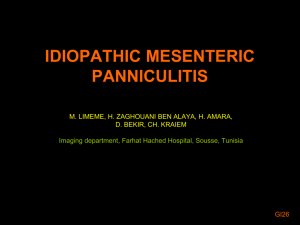
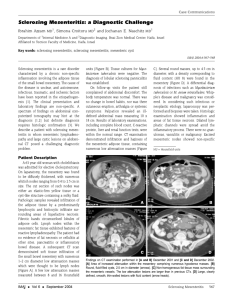
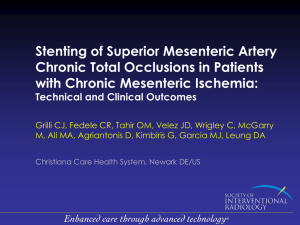

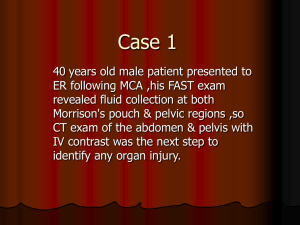
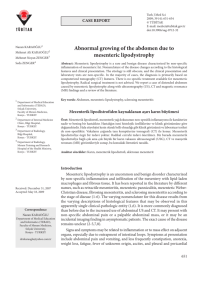
![Paper_Prof_Wang_final1[1]](http://s3.studylib.net/store/data/005836194_1-85fb8d8882c087decd1a6d9c9fdc99c0-300x300.png)
